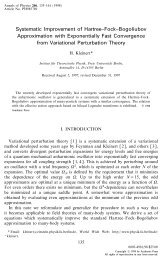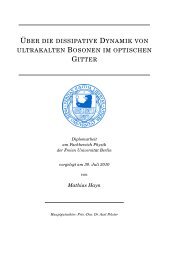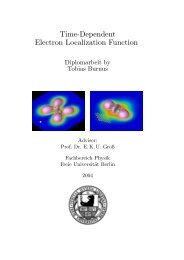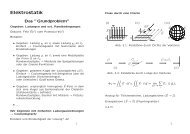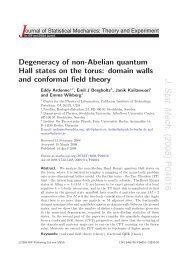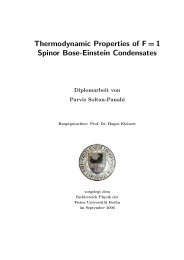Diploma thesis
Diploma thesis
Diploma thesis
You also want an ePaper? Increase the reach of your titles
YUMPU automatically turns print PDFs into web optimized ePapers that Google loves.
3 Complex square well potential<br />
The most important information these plots give us is the fact that the imaginary part of all<br />
states is always negative for 0 < c < ∞. This consolidates the assumption that the model of an<br />
imaginary potential describes dissipation since for the time evolution of the density (2.8) it yields<br />
a damping effect.<br />
Furthermore, the results of the real limit c → 0 are confirmed in Figs. 3.2(a) – 3.2(l) since the<br />
real part of the energy starts at some squared natural number ε R (c = 0) = m 2 and the imaginary<br />
part exactly at zero. Thus these solutions include the states of the real square well potential.<br />
It immediately catches the eye that we can generally differ between two kinds of solutions which<br />
are characterized by their imaginary part. For the states of the one type it is lim c→∞ ε I = 0 and<br />
for the other type a deeper consideration yields a linear decay lim c→∞ ε I = lim c→∞ (−c) = −∞.<br />
These limits correspond exactly to the imaginary part of the energies we obtained by evaluating<br />
ω → 0 and ω → π, which is ε 2 I,0 = 0 and ε I,∞ = −c in dimensionless variables. So while we<br />
counted all states for c = 0 by m, now for c → ∞ states with lim c→∞ ε I = 0 are counted by k so<br />
that we call them k-states ε k 0, and states with lim c→∞ ε I = −∞ are counted by n so that we call<br />
them n-states ε n ∞.<br />
Observing all 12 pictures one can see that for small waists there are only k-states among the lowest<br />
six states. For some ω < 0.1 the first n-state enters these lowest states namely the state starting<br />
at m = 5. In the course of increasing ω more and more states become n-states, so for some big<br />
waist ω > 1.1 even the k = 1-state is dropped out. Then we are left with 6 n-states among the<br />
lowest 6 energy levels so that for ω = π we have reached the constellation that we calculated in<br />
2<br />
Section 2 for w = L. Thus both limits are connected by a continuous rearrangement of k- and<br />
n-states among the lowest states.<br />
Now let us take a look at the situations where the waist is very close to 0 or π which yields that<br />
2<br />
area 2 or area 1 and 3 approximately vanish, respectively.<br />
3.2.1 Regime of vanishing areas<br />
We start with comparing Fig. 3.2(a) and Fig. 3.2(l) which represent a very small waist ω 0 and<br />
a very large waist ω π , respectively. From our former discussion we expect that approximately<br />
2<br />
the same constellation is represented as we calculated for the limits ω = 0 and ω = π, that 2<br />
means ε k 0 ≈ k 2 = m 2 and ε n ∞ ≈ n 2 − ic = m 2 − ic. This means that in both cases the real part<br />
is approximately unaffected of the dissipation c so for every strength of dissipation it should be<br />
nearly equal to m 2 . The imaginary part of the k-states for ω 0 is nearly equal to zero for all<br />
values of c and the imaginary part of the n-states for ω π approximately decreases with −c to<br />
2<br />
−∞, so ε n I,∞ + c is nearly equal to zero for all values of c.<br />
Let us compare this with the respective images and start with the n-states. Fig. 3.2(l), where<br />
ω = 1.57 ≈ π, shows that the real part is nearly constant and equal to 2 n2 = m 2 so the real part<br />
is correct. To prove for the imaginary part ε n I,∞ ≈ −c it seems to be more comfortable to have a<br />
look at ε n I,∞ + c and to show that it tends to be equal to zero for all c and ω → π:<br />
2<br />
14




